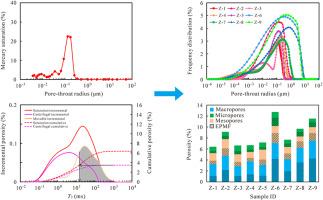Microscopic pore-throat structure and fluid mobility of tight sandstone reservoirs in multi-provenance systems, Triassic Yanchang formation, Jiyuan area, Ordos basin
IF 3.6
引用次数: 0
Abstract
The tight sandstone reservoirs in the first sub-member of Chang 7 member (Chang 71) of Triassic Yanchang Formation in the Jiyuan area, Ordos Basin, show significant variations in microscopic pore-throat structure (PTS) and fluid mobility due to the influences of the northeast and northwest dual provenance systems. This study performed multiple experimental analyses on nine samples from the area to determine the petrological and petrophysical properties, as well as the PTS characteristics of reservoirs in different provenance-controlled regions. On this basis, the pore-throat size distribution (PSD) obtained from high-pressure mercury injection (HPMI) was utilized to convert the NMR movable fluid T2 spectrum, allowing for quantitative characterization of the full PSD and the occurrence characteristics of movable fluids. A systematic analysis was conducted on the primary controlling factors affecting fluid mobility in the reservoir. The results indicated that the lithology in the eastern and western regions is lithic arkose. The eastern sandstones, being farther from the provenance, exhibit higher contents of feldspar and lithic fragments, along with the development of more dissolution pores. The reservoir possesses good petrophysical properties, low displacement pressure, and high pore-throat connectivity and homogeneity, indicating strong fluid mobility. In contrast, the western sandstones, being nearer to the provenance, exhibit poor grain sorting, high contents of lithic fragments, strong compaction and cementation effects, resulting in poor petrophysical properties, and strong pore-throat heterogeneity, revealing weak fluid mobility. The range of full PSD in the eastern reservoir is wider than that in the western reservoir, with relatively well-developed macropores. The macropores are the primary space for occurrence of movable fluids, and controls the fluid mobility of the reservoir. The effective porosity of movable fluids (EPMF) quantitatively represents the pore space occupied by movable fluids within the reservoir and correlates well with porosity, permeability, and PTS parameters, making it a valuable parameter for evaluating fluid mobility. Under the multi-provenance system, the eastern and western reservoirs underwent different sedimentation and diagenesis processes, resulting in differential distribution of reservoir mineral components and pore types, which in turn affects the PTS heterogeneity and reservoir quality. The composition and content of reservoir minerals are intrinsic factors influencing fluid mobility, while the microscopic PTS is the primary factor controlling it. Low clay mineral content, well-developed macropores, and weak pore-throat heterogeneity all contribute to the storage and seepage of reservoir fluids.

鄂尔多斯盆地姬塬地区三叠系延长组多物源体系致密砂岩储层微观孔喉结构及流体可动性
鄂尔多斯盆地姬塬地区三叠系延长组长7一亚段(长71)致密砂岩储层受东北、西北双物源体系的影响,微观孔喉结构(PTS)和流体流动性发生显著变化。本研究对该地区的9个样品进行了多次实验分析,确定了不同物源控制区储层的岩石学和岩石物理性质以及PTS特征。在此基础上,利用高压压汞(HPMI)获得的孔喉尺寸分布(PSD)对核磁共振可动流体T2谱进行转换,定量表征全孔喉尺寸分布和可动流体赋存特征。对影响储层流体流动性的主要控制因素进行了系统分析。结果表明,东、西部地区岩性为岩屑砂岩。东部砂岩离物源较远,长石和岩屑含量较高,溶蚀孔发育较多。储层岩石物性好,驱替压力低,孔喉连通性和均匀性高,流体流动性强。西部砂岩离物源较近,颗粒分选差,岩屑含量高,压实作用和胶结作用强,岩石物性差,孔喉非均质性强,流体流动性弱。东部储层全PSD范围较西部宽,大孔隙发育较好。大孔隙是可动流体的主要赋存空间,控制着储层流体的流动性。可动流体有效孔隙度(EPMF)定量表征了储层内可动流体所占据的孔隙空间,并与孔隙度、渗透率和PTS参数具有良好的相关性,是评价流体流动性的重要参数。在多物源体系下,东西部储层经历了不同的沉积成岩作用,导致储层矿物组分和孔隙类型分布差异,进而影响了PTS非均质性和储层质量。储层矿物组成和含量是影响流体流动性的内在因素,微观PTS是控制流体流动性的主要因素。黏土矿物含量低、大孔隙发育、孔喉非均质性弱是储层流体储集和渗流的重要因素。
本文章由计算机程序翻译,如有差异,请以英文原文为准。
求助全文
约1分钟内获得全文
求助全文

 求助内容:
求助内容: 应助结果提醒方式:
应助结果提醒方式:


